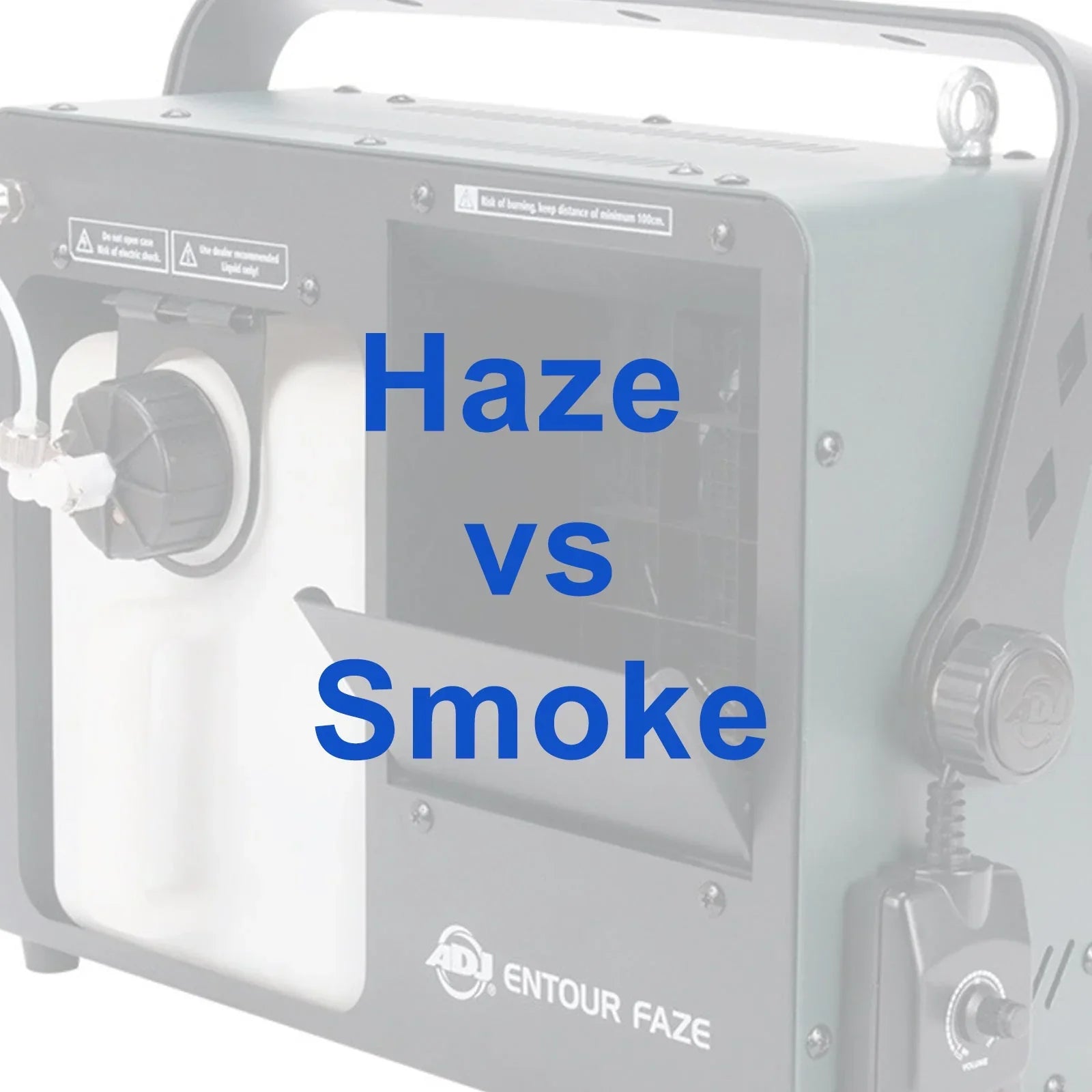When setting up for a live performance, event, or production, you may have heard about haze machines and smoke machines. Both devices are used to create atmospheric effects that enhance lighting and special effects, but they are not the same! While they share some similarities, the difference between haze machines and smoke machines lies in how they work, the type of effect they produce, and their best uses in various settings.
In this blog post, we’ll break down the key differences between haze and smoke, explain how each machine works, and help you decide which one to choose for your next event.
What is a Haze Machine? 💨
A haze machine is designed to create a fine, even mist or haze in the air. This haze is typically thinner and less dense than smoke, providing a subtle, translucent effect that enhances lighting effects without obstructing visibility. The mist produced by a haze machine is perfect for lighting to shine through, creating dramatic effects and a moody atmosphere.
How Does a Haze Machine Work?
Haze machines use a fluid (often water-based or oil-based) and heat it to create a very fine mist. The mist is then dispersed into the air, creating a thin, consistent haze that lingers in the atmosphere. Unlike smoke machines, which create a thicker, denser fog, haze machines create a more uniform and subtle effect. The haze allows lights, lasers, and other special effects to be more visible without blocking the view of the audience.
Common Uses of Haze Machines:
-
Enhancing Light Beams 🌟: Perfect for making light beams and lasers stand out during concerts, club events, and theatrical productions.
-
Creating a Dreamy Atmosphere ✨: Used in environments where you want a light, ethereal effect that doesn't obscure visibility but still adds to the mood.
-
Professional Lighting Displays 💡: Popular for use in clubs, theatres, concerts, and TV productions where subtle atmospheric effects are needed to complement the lighting design.
What is a Smoke Machine? 🔥
A smoke machine, also known as a fog machine, creates a dense, thick fog or smoke effect in the air. Unlike haze machines, smoke machines produce heavier smoke that lingers in the air for a longer time. The effect is much more pronounced and visible, often used to create dramatic moments or to cover areas of a stage or room for specific effects.
How Does a Smoke Machine Work?
Smoke machines generate smoke by heating fog fluid (usually glycol or glycerin-based) to produce a dense, heavy fog. When the fluid is heated, it vaporizes and is emitted through a nozzle or vent, creating a cloud of smoke that can fill a room or stage. The smoke produced is much denser and can obstruct visibility, creating a mysterious or dramatic effect.
Common Uses of Smoke Machines:
-
Dramatic Effects 🎭: Often used in theater productions, Halloween events, or concerts to create big, bold effects that capture attention.
-
Covering the Stage 🌫️: Used to obscure visibility temporarily, whether it’s to create mystery or to make something appear through the fog (e.g., a performer or special effects).
-
Horror & Special Events 💀: Perfect for haunted houses, horror-themed parties, or any event that needs a thick, dramatic fog.
Key Differences Between Haze Machines and Smoke Machines 💭
While both haze machines and smoke machines create atmospheric effects, they each serve very different purposes. Here’s a breakdown of the key differences:
| Feature | Haze Machines | Smoke Machines |
|---|---|---|
| Effect Type | Fine, light mist or haze | Dense, thick fog or smoke |
| Density | Thin, subtle, and transparent | Thick and opaque, can obscure vision |
| Duration | Lingers in the air but is less noticeable | Can linger for a long time |
| Primary Use | Enhancing lighting, lasers, and effects | Creating dramatic, thick fog or smoke |
| Visibility Impact | Does not obscure the audience’s view | Can obscure visibility and create mystery |
| Fluid Type | Water-based or oil-based fluid | Glycol or glycerin-based fluid |
When Should You Choose a Haze Machine? 🎶
If you're aiming for an atmospheric effect where lighting, lasers, or other special effects need to be highlighted without obstructing the view, a haze machine is your best option. It works well in settings where you want to subtly enhance the ambiance and create a dreamy, mysterious, or ethereal atmosphere.
-
Concerts and Events: Use haze to make light beams stand out without blocking the view of the stage.
-
Theatre Productions: Subtle hazing can add mood and enhance the lighting design without distracting from the performance.
-
Nightclubs and DJ Events: Haze creates that dynamic atmosphere where lighting and lasers can shine and engage the crowd.
When Should You Choose a Smoke Machine? 🎇
If you’re looking for a bold, dramatic effect that needs to be seen and felt by the audience, a smoke machine is the way to go. Use it when you need to create impactful effects that are dense enough to obscure visibility and make a statement.
-
Theatre and Performance: Smoke is perfect for creating mystical entrances, dramatic effects, or spooky settings.
-
Special Events: Whether it's a Halloween party or a grand reveal at an event, a smoke machine can deliver an unforgettable moment.
-
Music Concerts: For creating intense mood shifts or a fog-filled stage during an electrifying performance.
Conclusion: Haze Machines vs Smoke Machines 💨🎇
In conclusion, both haze machines and smoke machines have their place in the world of special effects, but understanding the key differences between the two will help you choose the right one for your next event or production.
-
Haze machines are great for creating a subtle and ethereal effect, enhancing lighting and creating a dreamy atmosphere.
-
Smoke machines are ideal for bold, dense fog effects that create mystery and drama.
Whether you’re looking to highlight lighting effects with haze or create a dense fog for a dramatic reveal, both machines are crucial for setting the right mood and atmosphere for your audience.

